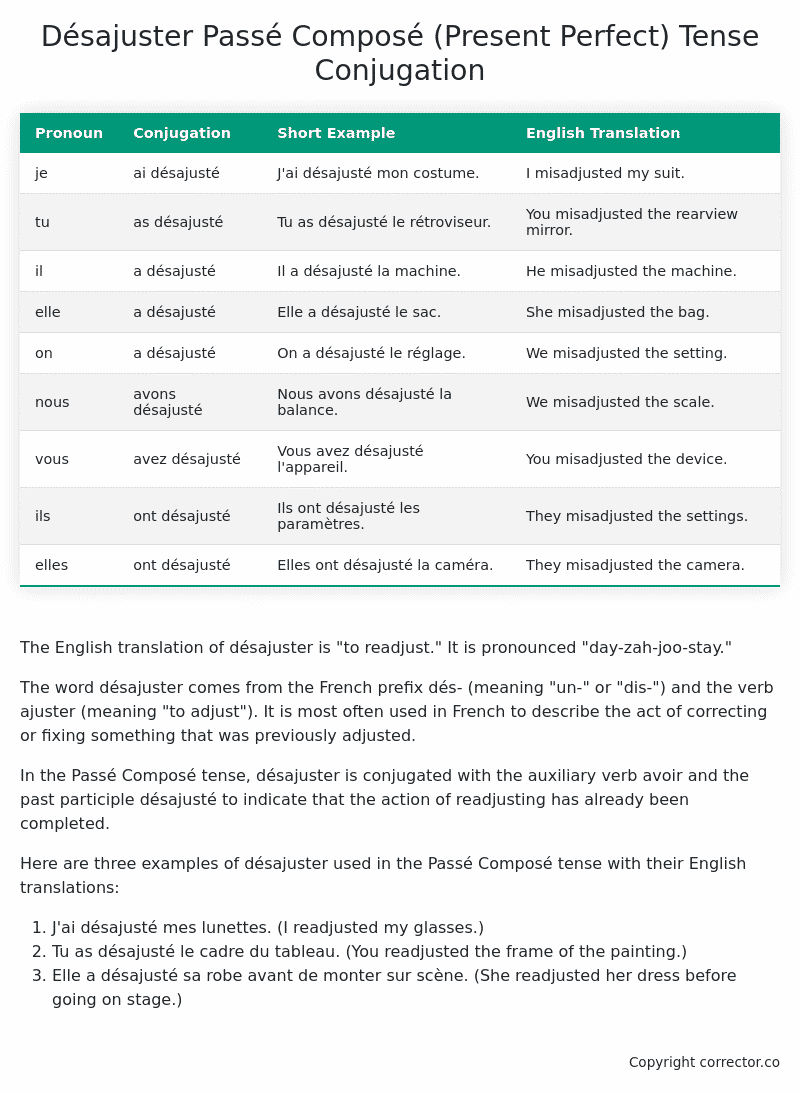Passé Composé (Present Perfect) Tense Conjugation of the French Verb désajuster
Introduction to the verb désajuster
The English translation of désajuster is “to readjust.” It is pronounced “day-zah-joo-stay.”
The word désajuster comes from the French prefix dés- (meaning “un-” or “dis-“) and the verb ajuster (meaning “to adjust”). It is most often used in French to describe the act of correcting or fixing something that was previously adjusted.
In the Passé Composé tense, désajuster is conjugated with the auxiliary verb avoir and the past participle désajusté to indicate that the action of readjusting has already been completed.
Here are three examples of désajuster used in the Passé Composé tense with their English translations:
- J’ai désajusté mes lunettes. (I readjusted my glasses.)
- Tu as désajusté le cadre du tableau. (You readjusted the frame of the painting.)
- Elle a désajusté sa robe avant de monter sur scène. (She readjusted her dress before going on stage.)
Table of the Passé Composé (Present Perfect) Tense Conjugation of désajuster
| Pronoun | Conjugation | Short Example | English Translation |
|---|---|---|---|
| je | ai désajusté | J’ai désajusté mon costume. | I misadjusted my suit. |
| tu | as désajusté | Tu as désajusté le rétroviseur. | You misadjusted the rearview mirror. |
| il | a désajusté | Il a désajusté la machine. | He misadjusted the machine. |
| elle | a désajusté | Elle a désajusté le sac. | She misadjusted the bag. |
| on | a désajusté | On a désajusté le réglage. | We misadjusted the setting. |
| nous | avons désajusté | Nous avons désajusté la balance. | We misadjusted the scale. |
| vous | avez désajusté | Vous avez désajusté l’appareil. | You misadjusted the device. |
| ils | ont désajusté | Ils ont désajusté les paramètres. | They misadjusted the settings. |
| elles | ont désajusté | Elles ont désajusté la caméra. | They misadjusted the camera. |
Other Conjugations for Désajuster.
Le Present (Present Tense) Conjugation of the French Verb désajuster
Imparfait (Imperfect) Tense Conjugation of the French Verb désajuster
Passé Simple (Simple Past) Tense Conjugation of the French Verb désajuster
Passé Composé (Present Perfect) Tense Conjugation of the French Verb désajuster (this article)
Futur Simple (Simple Future) Tense Conjugation of the French Verb désajuster
Futur Proche (Near Future) Tense Conjugation of the French Verb désajuster
Plus-que-parfait (Pluperfect) Tense Conjugation of the French Verb désajuster
Passé Antérieur (Past Anterior) Tense Conjugation of the French Verb désajuster
Futur Antérieur (Future Anterior) Tense Conjugation of the French Verb désajuster
Subjonctif Présent (Subjunctive Present) Tense Conjugation of the French Verb désajuster
Subjonctif Passé (Subjunctive Past) Tense Conjugation of the French Verb désajuster
Subjonctif Imparfait (Subjunctive Imperfect) Tense Conjugation of the French Verb désajuster
Subjonctif Plus-que-parfait (Subjunctive Pluperfect) Tense Conjugation of the French Verb désajuster
Conditionnel Présent (Conditional Present) Tense Conjugation of the French Verb désajuster
Conditionnel Passé (Conditional Past) Tense Conjugation of the French Verb désajuster
L’impératif Présent (Imperative Present) Tense Conjugation of the French Verb désajuster
L’infinitif Présent (Infinitive Present) Tense Conjugation of the French Verb désajuster
Struggling with French verbs or the language in general? Why not use our free French Grammar Checker – no registration required!
Get a FREE Download Study Sheet of this Conjugation 🔥
Simply right click the image below, click “save image” and get your free reference for the désajuster present perfect tense conjugation!

Désajuster – About the French Passé Composé (Present Perfect) Tense
Formation of the Passé Composé
Set the auxiliary verb with either
Conjugate the auxiliary verb
Add the past participle
Common everyday usage patterns
Narrating Past Events
Sequential Actions
Describing Completed Actions
Interactions with other tenses
Imperfect Tense
Conditional and Future Tenses
Summary
I hope you enjoyed this article on the verb désajuster. Still in a learning mood? Check out another TOTALLY random French verb conjugation!


